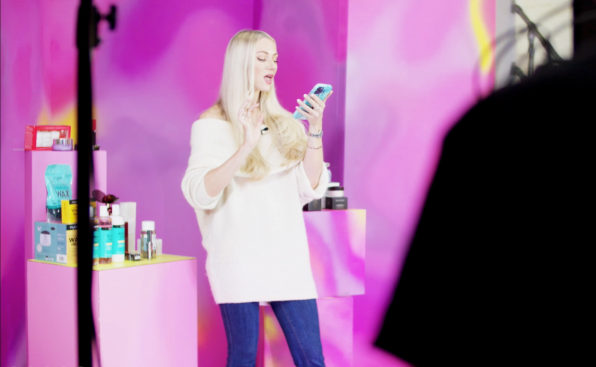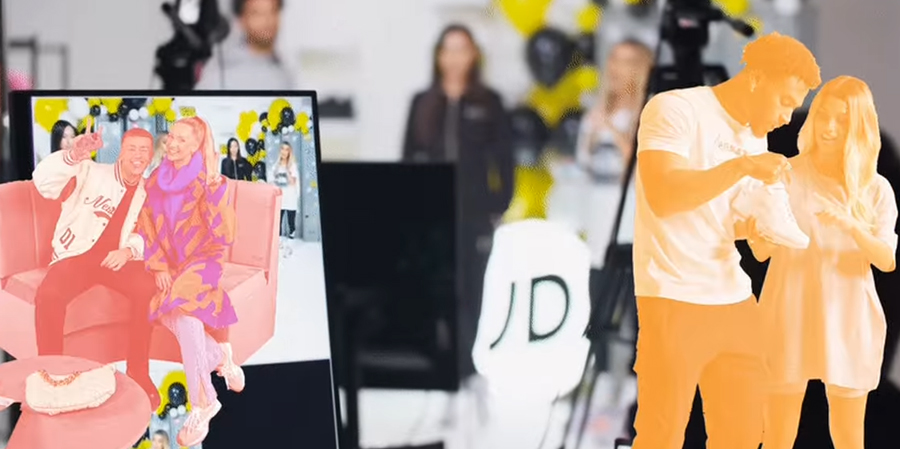The Western market is clamoring to replicate the runaway success of live commerce in China. And OOOOO is a newcomer with big ideas. But will they work?
Over the past 40 years, networks such as HSN and QVC have made live commerce a familiar concept: presenters gushing over the features and hard-to-beat prices of goods on live TV for consumers to buy.
However, live e-commerce is still a nascent enterprise in the United States, in particular, especially when you compare any efforts in the space to the powerhouse industry that’s been created in China.
Live e-commerce in the U.S. is expected to reach $35 billion in sales by 2024—not bad until that number is stacked against China, which is on track to hit $423 billion by this year alone.
Analysts project that live commerce could account for as much as 20% of all e-commerce in the next four years—and Sam Jones is aiming to replicate China’s runaway success in the West with his company OOOOO.
Founded in 2020, OOOOO, pronounced like an expression of excitement or wonder, is running a full-court press on digital live commerce.https://www.youtube.com/embed/0ZcLNH7y_vA?feature=oembed
The company, which started in the U.K., has an app where retailers including Boohoo, Missguided, and JD Sports have sold their wares in livestreamed events filmed from the company’s 20,000-square-foot studio in Manchester. If a brand wants their live shopping event to run on their own site or social channels, OOOOO allows them use of its studio, complete with themed sets, lighting, a production crew, and so forth. OOOOO takes a cut of sales in both scenarios.

“We’ve become a tech company and a studio company, which I didn’t see coming,” says Jones, cofounder and CEO of OOOOO, which currently only has physical soundstages in the U.K. “We can help people, cradle to grave, embrace video commerce and make sure that the brand equity is being truly reflected in the content.”
Additionally, OOOOO white labels its technology, powering live commerce on the back end for brands. The company also recently launched Fanz, a live-commerce destination similar to OOOOO but focused exclusively on soccer fandoms and incorporating NFTs.
“It is a bit like a grown-up version of Shopify,” says Jones of his startup’s expanding reach. “We just have to place our bets in this new mobile video economy.”
In some respects, it is just that: a bet.
“Chinese consumers are seen as one of the fastest-adopting groups in the world when it comes to new products and applications,” says Jialu Shan, a research fellow at the Global Center for digital business transformation at IMD Business School. For Western markets to attain the same level of growth that China has seen in live commerce is less about the technology than it is about consumers themselves.
“User acceptance also depends on many things, such as culture differences, mobile commerce differences—that also explains the reason why live commerce is still in its infancy in the West,” Shan says.

OOOOO certainly has some notable wins under its belt. The company toppled Amazon on the U.K. app charts back in March; it currently has more than 500,000 app installs globally. Brands such as Nike, Lego, and L’Oréal have sold product through OOOOO. The company struck a partnership with TikTok to help establish production studios in the U.K. and produce content. And the startup already counts QVC Italia and B2W, a leading online retailer in Latin America, as white-label clients.
But OOOOO is also stepping into an increasingly competitive landscape of companies looking to adapt the fervor of live e-commerce to the West.
Origins
Back in 2015, Jones founded the now defunct mobile soccer game Ballr based out of Hong Kong. Running a tech company in China gave him insight into how Chinese audiences consume on mobile.
“It’s very obvious if you just hang out in China for more than 10 minutes [that consumers]are many years further ahead on mobile,” Jones says. “They live their lives on phones, whether it’s [for]payments or entertainment or shopping. Everything’s done through phone.”
Jones had a brief stint as managing director for the e-commerce company Wish around the time that Chinese mobile commerce companies including Taobao Live, Pinduoduo, and Kuaishou rose to prominence.https://www.youtube.com/embed/KJIH3DSv3mc?feature=oembed
“I really felt like we should have been doing a lot more in video and live commerce,” says Jones, who left Wish in 2019. “And two years ago, I decided I’m sick and tired of watching. It’s time that we built something to bring this to the West.”
OOOOO started as a private company in the U.K., raising around $5 million in initial funding. But when Jones began pitching more VCs, he says, “Everyone liked the thesis, but they didn’t necessarily want to jump in at the time. I knew we had to move so quick.”
Jones moved the company’s headquarters to Canada, raised $15 million Canadian dollars (nearly $12 million) in a private placement offering, and took the company public on the Toronto Stock Exchange last July. “I felt like the Canadian market knew this form of commerce a little because Shopify is from there,” Jones explains.
Tech that makes you go ooooo . . .
Jones founded OOOOO alongside Eric Zhang, a founding member of Musical.ly and former senior engineer at TikTok. In addition to being cofounder, Zhang also oversees OOOOO’s team in Shanghai that’s responsible for developing the company’s technology.
“When a lot of people say ‘live commerce,’ they think it’s just like a live feed with a shopping button,” Jones says. “But actually the technology in China is much more complicated than that.”
For example, there’s building a commission system, live-feed moderation, and in-app games designed to reward users with discounts (and keep them in the app longer). Jones is leaning on gamification and viral mechanics (e.g., rewarding a user with free or discounted products for recommending the app to friends) to amplify the engagement and entertainment value of OOOOO’s community, something he believes may be lacking in competitors such as Bambuser or Livescale.https://www.youtube.com/embed/F5sudjLKApM?feature=oembed
“There are a lot of [software development kits]in the market now that allow you to broadcast live,” he says. “The challenge you’ve got with that is it’s just a live feed, and if you’re gonna push it somewhere like your website, you might have, like, five people watching. So you’re back to the age-old problem of, How do I get eyeballs into this?”
There’s also the element of ensuring those eyeballs have something presentable to look at during a live shopping event, which is where OOOOO’s content studio comes into play.
“It’s actually quite easy to go live on social media or through a simple SDK [software development kit], but it’s [also]really easy to make rubbish content,” Jones says. “To actually make great content you need a degree of creativity. You need all of the camera equipment, the set.”
Finding your Groove
While the app and studio remain core facets of the company, that’s mainly tied to the U.K. Plus, it’s not quite driving revenue in a meaningful way yet. OOOOO’s top-selling live show pushed just over 35,000 pounds (nearly $48,000) worth of products, and any show’s best conversion rate stands at 20%.
To grow OOOOO internationally, Jones is putting an emphasis on landing software-as-a-service deals with major companies, as well as finding distinct avenues to own. Categories like fashion and beauty tend to thrive on live commerce—and for that reason they are incredibly saturated markets.
“I can’t compete with Sephora. They’ve got all the celebrities, all the brands. It’s better for me to say, ‘Here’s the infrastructure, take it, you run it,’” Jones says. “But I think there are a few instances where OOOOO as a company has a very good position to say, for this particular community, we’re in a strong position to serve.”

That community is soccer fans.
In January, Jones launched Fanz.com as a new venture under OOOOO in partnership with Teddy Sagi, the Israeli billionaire behind gambling software company Playtech. In addition to hosting live-commerce events and in-app gaming, Fanz will also allow athletes and teams to sell digital merch as NFTs.
“If you look at what succeeds the most with OOOOO video commerce, it’s wherever there’s a culture, wherever there’s a community,” Jones says. “You can sell wine to the community, or sneakers. Cycling has a big culture to it. Now there’s no bigger tribe on the planet than soccer fans.”
Cracking the consumption capital
But the question remains: Is it all enough for OOOOO to be a top contender in live commerce in the West, particularly in the U.S.?
California-based startups Talk Shop Live, PopShop Live, and Ntwrk have been gaining steady traction over the years. Meta pulled the trigger on live shopping functionality across Instagram and Facebook last year. Although Amazon Live has been met with a tepid response since launching in 2019, Amazon certainly has the resources to rally itself.
“Already, live commerce is difficult for companies like Amazon, who have millions of active users; it would be even harder for a small startup like OOOOO to stand out,” says Shan of the IMD Business School.
She also argues that Western consumers are still adapting to cross-functional platforms. Amazon and eBay developed with a sole focus on e-commerce; Facebook and Instagram, social; YouTube, entertainment. Only recently have these platforms started integrating commerce functionality, whereas Chinese consumers have long been indoctrinated to the idea of e-commerce across social and communication platforms including Xiaohongshu, WeChat, and Weibo.
“The internet environment is completely different [in China],” Shan says. “So the approaches [in the West]should also be adapted.
“But the good sign is with more players piloting live commerce in the West,” she adds, “more users will experience the beauty of it, thus promoting live commerce.”
Jones is keen to leverage that momentum. “OOOOO is turning into an infrastructure play for the livestream economy,” he says. “Anywhere where there’s a big company with lots of budget, lots of consumers, lots of products who want to express their products through video, we are in discussions. The U.S. is the most important market. We all know that and I think we’ve got something to bring.”




